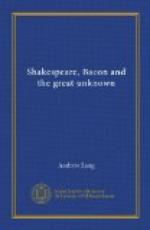About 1694, a year after Mr. Dowdall in 1693, and eighty years almost after Shakespeare’s death, W. Hall, a Queen’s man, Oxford (the W. Hall, perhaps, who gave the Bodleian Aldine Ovid, with Shakespeare’s signature, true or forged, to its unknown owner), went to Stratford, and wrote about his pilgrimage to his friend Mr. Thwaites, a Fellow of Queen’s. Mr. Hall heard the story that Shakespeare was the author of the mean and vulgar curse. He adds that there was a great ossuary or bone-house in the church, where all the bones dug up were piled, “they would load a great number of waggons.” Not desiring this promiscuity, Shakespeare wrote the Curse in a style intelligible to clerks and sextons, “for the most part a very ignorant sort of people.”
If Shakespeare did, that accommodation of himself to his audience was the last stroke of his wisdom, or his wit. {189a} Of course there is no evidence that he wrote the mean and vulgar curse: that he did is only the pious hope of the Baconians and Anti-Willians.
Into the question of the alleged portraits of Shakespeare I cannot enter. Ben spoke well of the engraving prefixed to the First Folio, but Ben, as Mr. Greenwood says, was anxious to give the Folio “a good send-off.” The engraving is choicely bad; we do not know from what actual portrait, if from any, it was executed. Richard Burbage is known to have amused himself with the art of design; possibly he tried his hand on a likeness of his old friend and fellow-actor. If so, he may have succeeded no better than Mary Stuart’s embroiderer, Oudry, in his copy of the portrait of her Majesty.
That Ben Jonson was painted by Honthorst and others, while Shakespeare, as far as we know, was not, has nothing to do with the authorship of the plays. Ben was a scholar, the darling of both Universities; constantly employed about the Court in arranging Masques; his learning and his Scottish blood may have led James I to notice him. Ben, in his later years, was much in society; fashionable and literary. He was the father of the literary “tribe of Ben.” Thus he naturally sat for his portrait. In the same way George Buchanan has, and had, nothing like the fame of Knox. But as a scholar he was of European reputation; haunted the Court as tutor of his King, and was the “good pen” of the anti-Marian nobles, Murray, Morton, and the rest. Therefore Buchanan’s portrait was painted, while of Knox we have only a woodcut, done, apparently, after his death, from descriptions, for Beza’s Icones. The Folio engraving may have no better source. Without much minute research it is hard to find authentic portraits of Mary Stuart, and, just as in Shakespeare’s case, {190a} the market, in her own day and in the eighteenth century, was flooded with “mock-originals,” not even derived (in any case known to me) from genuine and authentic contemporary works.
One thing is certain about the Stratford bust. Baconians will believe that Dugdale’s man correctly represented the bust as it was in his time; and that the actual bust is of 1748, in spite of proofs of Dugdale’s man’s fantastic inaccuracy; in spite of the evidence of style; and in spite of documentary evidence that “the original monument” was not to be destroyed and replaced by the actual monument, but was merely “repaired and beautified” (painted afresh) by a local painter.




